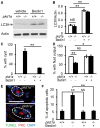Autophagy activators suppress cystogenesis in an autosomal dominant polycystic kidney disease model
- PMID: 28007903
- PMCID: PMC6251521
- DOI: 10.1093/hmg/ddw376
Autophagy activators suppress cystogenesis in an autosomal dominant polycystic kidney disease model
Abstract
Autosomal dominant polycystic kidney disease (ADPKD) is caused by mutations in either PKD1 or PKD2. It is one of the most common heritable human diseases with eventual development of renal failure; however, effective treatment is lacking. While inhibition of mechanistic target of rapamycin (mTOR) effectively slows cyst expansions in animal models, results from clinical studies are controversial, prompting further mechanistic studies of mTOR-based therapy. Here, we aim to establish autophagy, a downstream pathway of mTOR, as a new therapeutic target for PKD. We generated zebrafish mutants for pkd1 and noted cystic kidney and mTOR activation in pkd1a mutants, suggesting a conserved ADPKD model. Further assessment of the mutants revealed impaired autophagic flux, which was conserved in kidney epithelial cells derived from both Pkd1-null mice and ADPKD patients. We found that inhibition of autophagy by knocking down the core autophagy protein Atg5 promotes cystogenesis, while activation of autophagy using a specific inducer Beclin-1 peptide ameliorates cysts in the pkd1a model. Treatment with compound autophagy activators, including mTOR-dependent rapamycin as well as mTOR-independent carbamazepine and minoxidil, markedly attenuated cyst formation and restored kidney function. Finally, we showed that combination treatment with low doses of rapamycin and carbamazepine was able to attenuate cyst formation as effectively as a single treatment with a high dose of rapamycin alone. In summary, our results suggested a modifying effect of autophagy on ADPKD, established autophagy activation as a novel therapy for ADPKD, and presented zebrafish as an efficient vertebrate model for developing PKD therapeutic strategies.
© The Author 2016. Published by Oxford University Press. All rights reserved. For Permissions, please email: journals.permissions@oup.com.
Figures






Comment in
-
Polycystic kidney disease: Autophagy boost to treat ADPKD?Nat Rev Nephrol. 2017 Mar;13(3):134. doi: 10.1038/nrneph.2017.1. Epub 2017 Jan 16. Nat Rev Nephrol. 2017. PMID: 28090082 No abstract available.
Similar articles
-
Ablation of Long Noncoding RNA Hoxb3os Exacerbates Cystogenesis in Mouse Polycystic Kidney Disease.J Am Soc Nephrol. 2024 Jan 1;35(1):41-55. doi: 10.1681/ASN.0000000000000265. Epub 2023 Nov 13. J Am Soc Nephrol. 2024. PMID: 37953472 Free PMC article.
-
Curcumin inhibits cystogenesis by simultaneous interference of multiple signaling pathways: in vivo evidence from a Pkd1-deletion model.Am J Physiol Renal Physiol. 2011 May;300(5):F1193-202. doi: 10.1152/ajprenal.00419.2010. Epub 2011 Feb 23. Am J Physiol Renal Physiol. 2011. PMID: 21345977
-
Rapamycin-mediated suppression of renal cyst expansion in del34 Pkd1-/- mutant mouse embryos: an investigation of the feasibility of renal cyst prevention in the foetus.Nephrology (Carlton). 2012 Nov;17(8):739-47. doi: 10.1111/j.1440-1797.2012.01639.x. Nephrology (Carlton). 2012. PMID: 22725947 Free PMC article.
-
Impact of mammalian target of rapamycin inhibition on autosomal-dominant polycystic kidney disease.Transplant Proc. 2010 Nov;42(9 Suppl):S44-6. doi: 10.1016/j.transproceed.2010.07.008. Transplant Proc. 2010. PMID: 21095452 Review.
-
Role of apoptosis in the development of autosomal dominant polycystic kidney disease (ADPKD).Cell Tissue Res. 2017 Jul;369(1):27-39. doi: 10.1007/s00441-017-2628-6. Epub 2017 May 30. Cell Tissue Res. 2017. PMID: 28560694 Review.
Cited by
-
Ferroptosis Promotes Cyst Growth in Autosomal Dominant Polycystic Kidney Disease Mouse Models.J Am Soc Nephrol. 2021 Nov;32(11):2759-2776. doi: 10.1681/ASN.2021040460. J Am Soc Nephrol. 2021. PMID: 34716241 Free PMC article.
-
Targeting and therapeutic peptide-based strategies for polycystic kidney disease.Adv Drug Deliv Rev. 2020;161-162:176-189. doi: 10.1016/j.addr.2020.08.011. Epub 2020 Aug 29. Adv Drug Deliv Rev. 2020. PMID: 32866560 Free PMC article. Review.
-
Autophagy induction promotes renal cyst growth in polycystic kidney disease.EBioMedicine. 2020 Oct;60:102986. doi: 10.1016/j.ebiom.2020.102986. Epub 2020 Sep 16. EBioMedicine. 2020. PMID: 32949996 Free PMC article.
-
Allelic heterogeneity of TTNtv dilated cardiomyopathy can be modeled in adult zebrafish.JCI Insight. 2024 Apr 8;9(7):e175501. doi: 10.1172/jci.insight.175501. JCI Insight. 2024. PMID: 38412038 Free PMC article.
-
Renal plasticity revealed through reversal of polycystic kidney disease in mice.Nat Genet. 2021 Dec;53(12):1649-1663. doi: 10.1038/s41588-021-00946-4. Epub 2021 Oct 11. Nat Genet. 2021. PMID: 34635846 Free PMC article.
References
MeSH terms
Substances
Grants and funding
LinkOut - more resources
Full Text Sources
Other Literature Sources
Molecular Biology Databases
Miscellaneous

